
Research
Research
Our group studies the creation of ultrafast flashes of light (the source side) and the interaction of this ultrafast light with matter (the detector side) using a variety of numerical and analytic methods, ranging from the solution of the Schrodinger equation to semi-classical approaches to techniques from nonlinear dynamical systems. Below are some topics of current interest, both on the source and the detector side.
Capturing attosecond electron dynamics in atoms, molecules and condensed matter systems
The key experimental tools in ultrafast science are ultrafast optical and IR pulses (few cycle pulses in the range of visible light, corresponding to about 400-800 nm) and attosecond pulses in the XUV range of the spectrum (corresponding to 10-100 nm wavelength). These two types of pulses interact very differently with matter, since XUV photon energy is close to ionisation potential of valence shell electrons (leading to single photon ionisation), while optical and IR pulses ionize either via tunnel or multi-photon ionisation. We study how these different types of laser pulses can be used to excite and control matter.
TUNNEL IONIZATION IN ATOMS AND MOLECULES
A fundamental process in ultrafast science is tunnel ionization, whereby a strong laser field bends the binding potential of the atom or molecule so that the bound electron tunnels out and is subsequently accelerated in the strong laser field. This process also underlies the creation of high frequency (in the XUV range) attosecond pulses via the process known as High Harmonic Generation (HHG). We investigate how experimental observables, such as momenta of electrons observed at the detector or HHG spectra, can be used to reconstruct electron dynamics before and after ionization in real time.
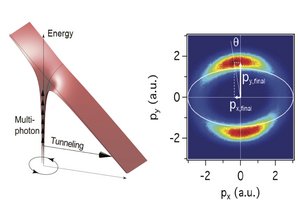
Left: Two possible ionisation channels with optical and IR laser fields. For stronger fields, the ionisation is dominated by tunnelling; Right: Electron momenta measured in tunnel ionisation experiment (taken from Landsman and Keller, Physics Reports, 547, 2015)
PROBING ATOMS AND MOLECULES WITH ATTOSECOND PULSES
Many state-of-the-art experiments employ a pump-probe scheme, combining relatively weak attosecond pulses to excite the dynamics (pump), which are subsequently probed with an IR pulse. This pump-probe scheme can be used to study electronic and vibrational properties of atoms and molecules, such as in quantum beat spectroscopy (see figure above), or probe the delays in single photon ionisation. Much theoretical analysis relies on the solution of the time dependent Schrodinger equation (TDSE), which however is possible only in simple atoms or highly symmetric molecules. Our group is developing classical and semi-classical methods to accurately describe ionisation of atoms and molecules using attosecond pulses. Such methods are much less computationally expensive than TDSE and can be used to accurately treat multi-electron dynamics in more complex systems, such as organic molecules.
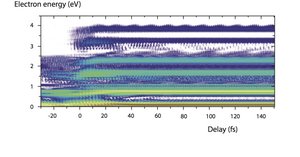
TDSE calculations of photoelectron spectra as a function of the delay between the IR femtosecond pulse and the xuv attosecond pulse (positive delays mean xuv pulse arrives first). Quantum beats are observed resulting from interference of different ionisation pathways involving two atomic states (taken from Lucchini et al, PRA 063406, 2015)
ATTOSECOND PHYSICS AT THE NANOSCALE
Electron tunnelling emission from a nanostructure due to strong DC fields has been widely used in modern science and technology because it produces bright and coherent electron beams. AC fields of an ultrashort laser pulse can produce ultrashort coherent sources of electron beams, if the dominant ionization mechanism is via tunnel (as opposed to multi-photon) emission. We are developing analytical and numerical methods to understand interaction of nano-structures with ultrafast laser pulses. Of particular interest is finding the correct ionisation model (see Panels A-C in figure above) and understanding better the rescattering mechanism. This is a relatively new field where common analytic tools of strong field physics (such as the dipole approximation) break-down and new behaviour emerges.
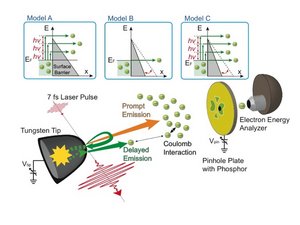
Interaction of a tungsten nano-tip with an ultrafast laser pulse, including different emission mechanisms. Model A: multi-photon; Model B: tunneling; Model C: mixture of tunneling and multi-photon
Creation of ultrashort light pulses: from X-ray to mid-IR frequencies
Although few cycle pulses at optical and IR frequencies are now produced in a number of labs, production of subcycle light transients (meaning optical and IR pulses of attosecond duration) remains a considerable technological challenge. At another part of the spectrum, the traditional method of HHG produces attosecond sources of XUV photons, but cannot produce frequencies in the X-ray regime. Hence we are interested in developing new theoretical methods for the production of attosecond sources, both in the low frequency and high frequency parts of the spectrum.
X-RAY ATTOSECOND PULSES
Coherent high intensity x-ray sources of radiation are now becoming available with Free Electron Lasers (FELs), as well as more compact devices using HHG with mid-IR driving sources, or laser-plasma interaction. While traditionally available XUV sources have frequencies that corresponds to ionization potential of valence electrons, x-rays ionize core states in atoms and molecules. X-ray sources can therefore be used to study inner shell dynamics and electron re-arrangement following removal of an electron, including processes like Auger decay. We are interested in how few cycle pulses can be used to create attosecond sources with photon frequencies in the x-ray range.
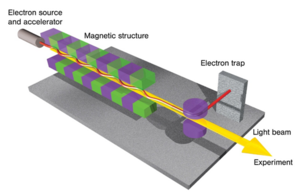
Schematic of how coherent, high power and peak brightness x-ray light beams are created with a Free Electron Laser.
SUBCYCLE LIGHT TRANSIENTS
Subcycle transients confine light-matter interaction to a sub-femtosecond time-scale, providing unprecedented resolution of important electronic processes, including tunneling. The creation of such pulses requires generation of a broad spectrum, going down to zero frequency components, which cannot be created using traditional nonlinear optics methods. It is possible to generate such frequencies using Carrier Wave Rabi Flopping (CWRF), which occurs when the driven light intensity is so high that the period of one Rabi oscillation is comparable with that of one cycle of light. In this case, the interaction of a bound electron with light is highly irregular (see figure above), leading to significant reshaping of the light pulse. Hence, it may be possible to create sub-cycle pulses by resonantly exciting atoms with a few cycle pulse of intensity strong enough to enter the CWRF regime. We are interested in how CWRF can be used to reshape laser pulses, as well as to precisely control the transfer of the ground state population in atoms and molecules.
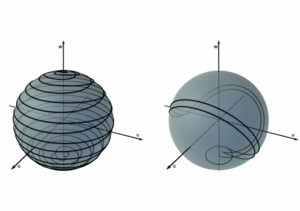
Left: Conventional Rabi flopping showing regular motion on a Bloch sphere, where the electron returns to its ground state after the laser pulse has passed. Right: Carrier Wave Rabi Flopping (CWRF) results in irregular motion on the Bloch sphere and the reshaping of the driving laser pulse (taken from Ciappina et al, Phys. Rev. Letters, 143902, 2015)